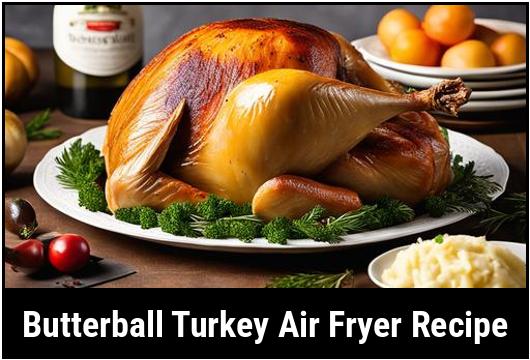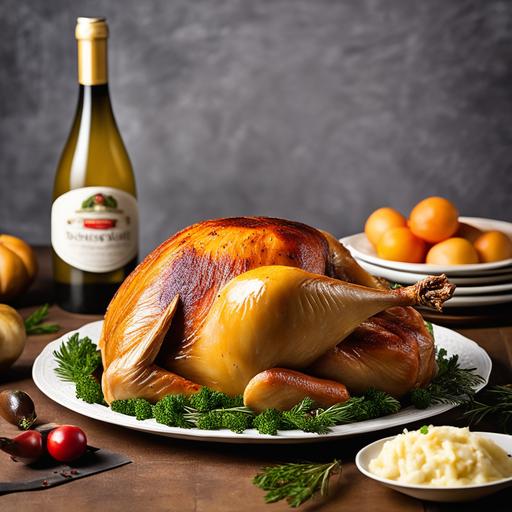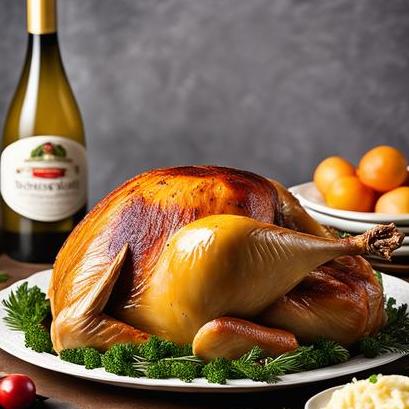
The Perfect Butterball Turkey Air Fryer Recipe: A Comprehensive Guide
Cooking a Butterball turkey in an air fryer can be a game-changer in the kitchen. With its convection cooking technology, an air fryer can provide a succulent and evenly cooked turkey with a crispy skin. This article will explore the food science behind cooking a Butterball turkey in an air fryer, from choosing the right ingredients to the recommended air fryer temperature and timing. Additionally, a mouthwatering recipe for cooking a delicious and juicy Butterball turkey in an air fryer will be provided to help you achieve culinary perfection.
Food Science Behind Cooking Butterball Turkey In An Air Fryer
Understanding the science behind cooking a Butterball turkey in an air fryer is essential for achieving the perfect results. The convection cooking method of an air fryer circulates hot air around the food, creating a crispy exterior while sealing in the juices. When cooking a Butterball turkey, the convection heat helps to cook the bird evenly, while the hot air rapidly dehydrates the skin, resulting in a beautifully golden and crispy finish.
Choosing Ingredients
Selecting the right ingredients for your Butterball turkey is crucial for a flavorful and moist outcome. When choosing a Butterball turkey, opt for a fresh or thawed bird. Fresh turkeys tend to be juicier and more flavorful, while avoiding a frozen turkey will ensure even cooking. Additionally, gather high-quality herbs, spices, and aromatics to season the turkey, enhancing its flavor profile.
Preparing Ingredients

Preparing the ingredients with care is paramount for a successful Butterball turkey in an air fryer. Thaw the turkey thoroughly if using a frozen one, allowing ample time for it to come to room temperature. Properly seasoning the turkey with an aromatic blend of herbs and spices will infuse it with rich flavors. Ensuring the skin is dry before seasoning will promote a crispy exterior during cooking.
Recommended Air Fryer Temperature & Timing
Achieving the ideal temperature and timing is vital for a perfectly cooked Butterball turkey in an air fryer. Preheating the air fryer is recommended to ensure even cooking. Cooking the turkey at a moderate temperature and monitoring the internal temperature with a meat thermometer will prevent drying out the bird while ensuring it is cooked to perfection.
Butterball Turkey Air Fryer Recipe
Ingredients
- 1 Butterball turkey, fresh or thawed
- 2 tablespoons of olive oil
- 2 teaspoons of salt
- 1 teaspoon of black pepper
- 1 teaspoon of garlic powder
- 1 teaspoon of onion powder
- 1 teaspoon of paprika
- Aromatic herbs such as thyme, rosemary, and sage
- Vegetables for the bed of the air fryer (carrots, onions, and celery)
Instructions
-
Preparation:
- Thaw the Butterball turkey completely if using a frozen one, and pat it dry with paper towels.
- Preheat the air fryer to 350°F (175°C).
-
Seasoning:
- In a small bowl, mix the salt, black pepper, garlic powder, onion powder, and paprika together to create a seasoning blend.
- Rub the entire surface of the turkey with olive oil, ensuring it is evenly coated.
- Generously season the turkey, both inside and out, with the prepared seasoning blend, and stuff the cavity with aromatic herbs.
-
Bed of Vegetables:
- Create a bed of vegetables (carrots, onions, and celery) at the bottom of the air fryer basket to elevate the turkey and infuse flavor.
-
Air Frying:
- Place the prepared Butterball turkey on the bed of vegetables in the air fryer basket.
- Cook the turkey in the air fryer at 350°F (175°C) for approximately 10-12 minutes per pound. For example, a 12-pound turkey would require around 2 to 2.5 hours of cooking time.
-
Monitoring:
- Halfway through the cooking time, baste the turkey with its natural juices or a mixture of melted butter and herbs for added flavor and moisture.
- Use a meat thermometer inserted into the thickest part of the turkey (typically the thigh) to ensure it reaches an internal temperature of 165°F (74°C) before removing it from the air fryer.
-
Resting and Carving:
- Once cooked, remove the Butterball turkey from the air fryer and let it rest for 15-20 minutes before carving. This allows the juices to redistribute, ensuring a moist and tender turkey.
Cooking a Butterball turkey in an air fryer can yield stellar results when utilizing the right techniques and understanding the food science behind it. By carefully choosing high-quality ingredients, properly preparing the turkey, and following the recommended air fryer temperature and timing, you can serve a juicy, flavorful, and crispy-skinned Butterball turkey that will undoubtedly impress your guests. With this comprehensive recipe and guide, you can master the art of cooking a Butterball turkey in an air fryer, elevating your culinary skills to new heights.
Doneness Checks
Air frying has become a popular cooking method due to its convenience and the ability to create delicious, crispy dishes with less oil. If you’re looking to cook a Butterball turkey in an air fryer, you’re in luck. With the right recipe and techniques, you can achieve a juicy and flavorful turkey with a perfectly crispy skin.
When cooking a Butterball turkey in an air fryer, it’s crucial to ensure that the turkey is fully cooked. Here are a few doneness checks you can perform to ensure your turkey reaches the desired level of doneness:
-
Internal Temperature: The most reliable way to determine if a turkey is cooked thoroughly is by checking its internal temperature with a meat thermometer. The USDA recommends that poultry, including turkey, should be cooked to an internal temperature of 165°F (74°C) in the thickest part of the thigh. By inserting the thermometer into the thickest part of the turkey, close to the bone but not touching it, you can accurately assess its doneness.
-
Color and Juices: Another visual clue for doneness is the color of the turkey’s juices. If the juices are clear, rather than pink or cloudy, it indicates that the turkey is cooked through. Additionally, the skin should be browned and crisp, and the meat should be opaque and moist.
Undercooking
Undercooking a turkey can lead to potential health risks, as poultry should be cooked thoroughly to eliminate any harmful bacteria. To avoid undercooking your Butterball turkey in an air fryer, consider the following tips:
-
Temperature and Time: It’s essential to follow the recommended temperature and cooking time guidelines given by Butterball. Most air fryer manufacturers also provide specific instructions for cooking poultry. Make sure to preheat the air fryer according to the manufacturer’s instructions and set it to the appropriate temperature required for cooking turkey. Additionally, adjust the cooking time based on the size of your turkey.
-
Use a Meat Thermometer: As mentioned earlier, using a meat thermometer is crucial for checking the internal temperature of the turkey. Be sure to insert the thermometer in the thickest part of the thigh, without touching the bone. If the temperature is below 165°F (74°C), continue cooking the turkey until it reaches the recommended internal temperature.
-
Check Multiple Areas: To ensure even cooking throughout the turkey, check the internal temperature in multiple areas. It’s possible for certain parts of the turkey to cook faster than others. By checking the temperature in different areas, you can ensure that all parts of the turkey are properly cooked.
Overcooking
Overcooking can result in a dry and tough turkey, which is not ideal for a flavorful and succulent meal. To prevent overcooking your Butterball turkey when using an air fryer, follow these suggestions:
-
Use a Timer: It’s easy to get distracted or lose track of time while cooking. To avoid overcooking, set a timer based on the recommended cooking time provided by Butterball or the air fryer manufacturer. Check the turkey’s internal temperature with a meat thermometer close to the predetermined time to ensure it doesn’t exceed the desired doneness.
-
Monitor the Skin: Pay close attention to the turkey’s skin while it’s cooking. If you notice the skin becoming too dark or starting to burn, it may be an indication that the turkey is becoming overcooked. Consider lowering the temperature or covering the turkey with aluminum foil to prevent further browning.
-
Baste the Turkey: Basting the turkey with butter or oil throughout the cooking process can help maintain its moisture and prevent it from drying out. Basting also helps with achieving a golden-brown, crispy skin. However, be mindful not to over-baste, as too much liquid can promote roasting rather than air frying.
Troubleshooting
Even with careful preparation, issues can still arise when cooking a Butterball turkey in an air fryer. Here are some common troubleshooting tips to help you overcome any difficulties:
-
Uneven Browning: If you notice that certain areas of the turkey are browning more than others, try rotating the turkey within the air fryer basket halfway through the cooking process. This will allow for more even browning and prevent any one side from becoming too dark.
-
Sticking to the Basket: To prevent the turkey from sticking to the air fryer basket, lightly grease the basket with cooking spray or oil before placing the turkey in it. Additionally, consider using a non-stick basket or lining the basket with parchment paper to further prevent sticking.
-
Dry Meat: If you find that the meat of the turkey is dry even though it has reached the recommended internal temperature, try brining the turkey before cooking. Brining involves soaking the turkey in a mixture of salt and water for several hours before cooking, which helps to retain moisture and enhance flavor.
Recipe Variations

While a basic Butterball turkey recipe is delicious on its own, you can explore various flavors and ingredients to put your own spin on it. Here are some recipe variations to try:
-
Herb-Roasted Turkey: Rub the turkey with a mixture of fresh herbs like rosemary, thyme, and sage, along with garlic and olive oil. This herb-infused turkey will bring an extra layer of aromatic flavors to your dinner table.
-
Citrus-Glazed Turkey: Create a tangy and slightly sweet glaze by combining freshly squeezed orange juice, honey, Dijon mustard, and a touch of brown sugar. Brush the glaze on the turkey during the last few minutes of cooking for a citrusy twist.
-
Spicy Cajun Turkey: For a Cajun-inspired turkey, mix together Cajun seasoning, paprika, cayenne pepper, garlic powder, and salt. Rub this spice mixture generously over the turkey to add a bold and spicy kick to your meal.
-
Herb Butter Under the Skin: Create a compound butter by mixing softened butter with finely chopped herbs, such as parsley, thyme, and rosemary. Gently loosen the skin of the turkey and spread the herb butter directly onto the meat. This will infuse the turkey with extra flavor and help keep the meat moist.
With the right techniques and attention to detail, you can cook a flavorful and succulent Butterball turkey using an air fryer. Remember to check the turkey’s internal temperature, avoid undercooking or overcooking, troubleshoot any issues that may arise, and explore different recipe variations to personalize your turkey dinner. With these tips and a bit of culinary creativity, you’ll have a delicious turkey that will impress your family and guests alike. Happy air frying!
Flavour Enhancement Tips
Turkey is a common protein source in most households, especially during the holiday season. However, cooking the perfect turkey can be a daunting task, which is why many people prefer to use air fryers instead of the oven. Among the different brands of turkeys, Butterball is a well-known turkey provider that has become a preferred choice for many households across the globe.
The success of any turkey dish largely depends on the flavors used. To bring out the best flavors of the Butterball turkey, use a mild rub or seasoning that complements the turkey flavor without overpowering it. A mixture of salt, black pepper, and garlic powder will make an excellent rub. Alternatively, you can use your preferred seasoning, but be mindful not to add too much.
If you want to add flavor to your Butterball turkey, consider doing a brine. A brined Butterball turkey is more flavorful and tender than a regular Butterball turkey. To brine, create a mixture of 1 cup of salt, 1/2 cup of sugar, 1 tbsp. of black pepper, 1 sliced onion, and 2 sliced lemons. Mix the ingredients in a pot of boiling water and let the mixture cool before placing your turkey in the pot. Leave the turkey to soak in the mixture for at least 12 hours before air frying.
Texture Enhancement Tips
The texture of the Butterball turkey is also crucial to enhance the overall culinary experience. A dry turkey is not pleasant to eat, and, therefore, it’s essential to ensure it remains moist during the cooking process. Stuffing the turkey with a few lemon slices or fresh herbs, such as parsley, rosemary, and thyme, can help enhance its juiciness.
Another tip is to baste the turkey during the cooking process with melted butter or oil to avoid dryness. Once the turkey is done, allow it to rest for at least ten minutes before serving. Resting allows the juices to distribute throughout the meat, thus enhancing its texture and making it juicy.
Cooking At Different Temperatures
Different air fryers have different temperature settings, but most air fryers have a temperature range of 300-400°F. The Butterball turkey cooking temperature will also depend on its size. A Butterball turkey that weighs 3 to 5 pounds should be cooked at 350°F, while a turkey that weighs more than five pounds should be cooked at 375°F.
Ensure you preheat your air fryer before cooking the Butterball turkey for at least 5 minutes to ensure consistent cooking. Once the air fryer is heated, place the turkey inside the basket and adjust the temperature and timer accordingly to the recommended cooking time stated on the packaging.
Cooking Tips
Cooking the perfect Butterball turkey in an air fryer requires some precision and technique. Below are some tips that can help ensure your turkey is perfectly cooked.
-
Always check the internal temperature of your turkey to ensure it’s properly cooked. The internal temperature should read 165°F when measured at the thickest part of the turkey.
-
Consider using a meat thermometer to check internal temperatures. A meat thermometer will help you determine if the turkey is cooked evenly or if it requires additional cooking time.
-
Avoid overcrowding the air fryer basket when cooking the turkey. Overcrowding the basket will limit the air circulation, leading to uneven cooking and dryness.
-
Baste the turkey with butter or oil every 30 minutes to avoid dryness.
-
If you notice that the turkey skin is turning brown rapidly, cover it with foil to avoid over-browning.
Serving Suggestions
A properly cooked Butterball turkey pairs well with a range of sides, including mashed potatoes, green beans, roasted vegetables, cranberry sauce, and gravy. Here are some serving suggestions:
-
Serve the turkey carved alongside your preferred sides for a classic turkey meal.
-
If you’re feeling adventurous, consider incorporating chopped turkey into a salad, sandwich, or wrap.
Conclusion
Cooking a Butterball turkey in an air fryer is a great way to reduce stress, save time, and create a delicious meal that everyone will enjoy. By following the tips outlined in this article, you can enhance the flavor and texture of your Butterball turkey, thus taking your culinary experience to the next level. Remember to always check the internal temperature, avoid overcrowding the air fryer, and baste your turkey regularly to avoid dryness. Lastly, serve your turkey alongside your preferred sides for a memorable meal.
FAQS On Butterball Turkey Air Fryer Recipe
What Is The Best Size Butterball Turkey To Use For The Air Fryer?
It is recommended to use a Butterball turkey that weighs around 12 pounds or less for optimal cooking in the air fryer. Smaller turkeys tend to cook more evenly and result in a juicier end product.
Do I Need To Thaw The Butterball Turkey Before Air Frying?
Yes, it is crucial to fully thaw the Butterball turkey before air frying. Make sure to follow the proper thawing guidelines provided by the manufacturer to ensure food safety. Thawing in the refrigerator is the safest method and can take approximately 24 hours for every 4-5 pounds of turkey.
How Long Does It Take To Cook A Butterball Turkey In An Air Fryer?
Cooking times may vary depending on the size of the turkey and the specific air fryer model being used. As a general guideline, cook the Butterball turkey at 350°F for 10-12 minutes per pound. To ensure the turkey is properly cooked, use a meat thermometer to check for an internal temperature of 165°F in the thickest part of the turkey.
Can I Stuff The Butterball Turkey Before Air Frying?
It is not recommended to stuff the Butterball turkey before air frying. Stuffing the turkey may interfere with the cooking process and result in unevenly cooked or undercooked parts. If desired, you can prepare and cook the stuffing separately.
Should I Use Oil Or Butter When Air Frying A Butterball Turkey?
The Butterball turkey is already known for its rich and flavorful taste, so additional oil or butter is not necessary. However, you may lightly brush the turkey with a small amount of oil or melted butter for a crispy skin if desired.
Can I Season The Butterball Turkey Before Air Frying?
Absolutely! Seasoning the Butterball turkey before air frying adds delicious flavor. You can use a variety of seasonings such as salt, pepper, garlic powder, onion powder, paprika, or any other preferred herbs and spices. Ensure that the seasoning is evenly distributed on the turkey for the best results.
How Do I Prevent The Butterball Turkey From Drying Out In The Air Fryer?
To prevent the Butterball turkey from drying out, it is important to cook it for the appropriate amount of time and at the recommended temperature. Additionally, you can baste the turkey with its own juices or broth periodically throughout the cooking process to keep it moist. Covering the turkey loosely with foil in the air fryer for the first half of the cooking time can also help retain moisture.


